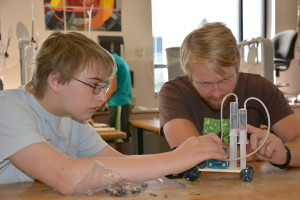There has long been a difficulty for some to learn subjects like math and science, often resorting to the age-old question: “When will I ever use this in life?” Students can become disheartened by not seeing the practical applications of these courses.
Michael De Miranda, a professor in CSU’s School of Education, is working to address this issue through his research in STEM learning.
STEM — an acronym for science, technology, engineering

and math — is intended to help students recognize how each subject plays a role in the development of a certain technology.
“The S and the T and the E and the M all have a connected relationship,” De Miranda said. “The STEM-literate and -capable person is able to fluidly connect the dots.”
De Miranda designed a collaborative project by building teams of STEM teachers with the goal of teaching projects that use all four subjects at once.
“When students are taught STEM subjects in a collaborative, interdisciplinary way centered on a relevant engineering design project, the low-scoring students are constantly showing statistically significant gains in their integrated STEM scores,” he said. Part of his research is centered on scale development to measure how students “connect the STEM dots.”
One example of STEM in practice was through implementation at Berthoud High School.
“The kids’ problem was to build an iPod music docking station,” De Miranda said. “The math teacher talked about amplifier gains. The physics teacher covered waves, electromagnetism and electronics. Those are three physics units. And in engineering, the teacher taught them how to design circuits, test and build it. We’ve brought engineering into the schools as the design thinking and utility piece.”
Another high school had the kids build a device to test bicycle helmets. So they made crash dummy heads, tested and built different helmets loaded with sensors, and gathered data. Another school had the students develop a project that tested the difference between running barefoot and running with shoes by building a sensor device that measured pressure.
Recently, the project has scaled up by partnering with engineering-oriented organizations Northrop Grumman and Intel, and is funded by the National Science Foundation. A STEM summer camp, held in Cherry Creek at Grandview High School, involves working with 45 teachers. This intensive and immersive STEM experience consists of teaching students cyber-security, biomedical science, clean energy, and C++ programming.
STEM learning has been developed in lockstep with the technological boom of the past decade.
“The ways in which humans think are fundamentally different because of the technological revolution. It’s life now,” De Miranda said. “It’s about unlocking that technological literacy of our nation. When we start to talk to kids about how this stuff works, they’re excited about it.”